
Video series. This class makes use of Seasons 1 - 10.
- Subject:
- Visual Arts
- Material Type:
- Case Study
- Lecture
- Primary Source
- Author:
- Barbara Illowsky
- Date Added:
- 02/16/2020

Video series. This class makes use of Seasons 1 - 10.

Conservators, scientists, and curators tell the story behind the unprecedented conservation of Tullio Lombardo's Adam. The life-size marble statue of Adam, carved by Tullio Lombardo (Italian, ca. 1455–1532), is among the most important works of art from Renaissance Venice to be found outside that city today. Made in the early 1490s for the tomb of Doge Andrea Vendramin, it is the only signed sculpture from that monumental complex. The serene, idealized figure, inspired by ancient sculpture, is deceptively complex. Carefully manipulating composition and finish, Tullio created God's perfect human being, but also the anxious victim of the serpent's wiles. In 2002, Adam was gravely damaged in an accident. Committed to returning it to public view, the Museum undertook a conservation treatment that has restored the sculpture to its original appearance to the fullest extent possible. The exhibition allows Adam to be viewed in the round and explains this unprecedented twelve-year research and conservation project. It also inaugurates a new permanent gallery for Venetian and northern Italian sculpture. The installation of this gallery was made possible by Assunta Sommella Peluso, Ignazio Peluso, Ada Peluso, and Romano I. Peluso.

Anila Quayyum Agha’s installation Alhambra Nights was selected to be included in the City of Cincinnati’s BLINK festival. The event spanned twenty city blocks and included light, interactive art, and large-scale projection mapping. Inspired by Agha’s visit to the Alhambra and her efforts to connect traditional Islamic art and architecture with contemporary technology and Western audiences.

At first glance, Katena might look like an ordinary inflatable with an unusually complex and oversized structure. But when they walk inside, visitors soon realize this is an entirely different experience. They enter a world apart, a world of interconnecting tunnels and domes saturated with light and color, called a luminarium. This video will take your students on a virtual tour of one luminarium that was featured at the Cincinnati BLINK festival. They will learn how the design team of Architects of Air blends geometry, art, and architecture to create a pneumatic, or air-filled, structure in which form must follow function.

Sanaz Mazinani is an artist with a background in political activism who uses art to inspire dialogue about perceptions of cultural identity. In the latest episode of Art School, she describes her current art practice. Using online media focusing on world news and pop culture as her source material, she creates symmetrical photo collages and videos that abstract familiar images and invite viewers to reconsider visual culture and its meaning and influence on public opinion and social justice. In this episode of Art School, she describes her current art practice and the intentions behind her recent installation at the Asian Art Museum in San Francisco.
In the second video Mazinani expands on the intention of traditional of Islamic ornamentation.
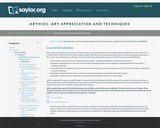
This course is an exploration of visual art forms and their cultural connections for the student with little experience in the visual arts. It includes a brief study of art history and in depth studies of the elements, media, and methods used in creative processes and thought. Upon successful completion of this course, students will be able to: interpret examples of visual art using a five-step critical process that includes description, analysis, context, meaning, and judgment; identify and describe the elements and principles of art; use analytical skills to connect formal attributes of art with their meaning and expression; explain the role and effect of the visual arts in societies, history, and other world cultures; articulate the political, social, cultural, and aesthetic themes and issues that artists examine in their work; identify the processes and materials involved in art and architectural production; utilize information to locate, evaluate, and communicate information about visual art in its various forms. Note that this course is an alternative to the Saylor FoundationĺÎĺ_ĺĚĺ_s ARTH101A and has been developed through a partnership with the Washington State Board for Community and Technical Colleges; the Saylor Foundation has modified some WSBCTC materials. This free course may be completed online at any time. (Art History 101B)

This lesson could be done with most adults and older kids. It is especially good for
elderly women, as many of them have fond memories of sewing and fabric crafts,
yet they can no longer do those crafts due to vision or fine motor impairments.
This project allows them to make something beautiful with fabric that doesn’t
involve any sewing.

Watch this short video and try to identify the location of the sculptures. Then see how art and these sculptures relate to the science of mathematics.
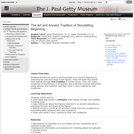
Students will discuss what is communicated in an ancient statuette by analyzing the size and poses of two figures. They will learn that stories were passed through oral tradition in ancient times. They will create sculptures of themselves, a companion, and a favorite musical instrument using spheres and cylinders, and then recite a story inspired by their sculptures.

Students learn how forces are used in the creation of art. They come to understand that it is not just bridge and airplane designers who are concerned about how forces interact with objects, but artists as well. As "paper engineers," students create their own mobiles and pop-up books, and identify and use the forces (air currents, gravity, hand movement) acting upon them.
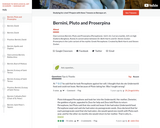
This art history video discussion examines Gian Lorenzo Bernini's "Pluto and Proserpina" (also know as the Rape of Proserpina), 1621-22, marble (Galleria Borghese, Rome). Proserpina is the Latin varient of the mythic Greek Persephone.

This art history video discussion looks at Bodhisattva, probably Avalokiteshvara (Guanyin), Northern Qi dynasty, c. 550--60, Shanxi Province, China, sandstone with pigments, 13-3/4 feet / 419.1 cm high (Metropolitan Museum of Art, New York).
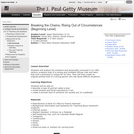
Students will analyze the emotions and personality conveyed in an 18th-century sculpture bust of a strong and confident African man and learn that such a portrayal is unique for its time. They will then create an original portrait bust of a strong person who has faced difficult situations.

Students will learn about ancient styles of Roman portraiture and their influence on western European art, research and write a paper that compares Roman and American slavery, and produce an original sketch of a grave relief for a freed slave.
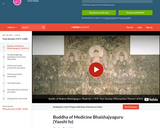
This art history video discussion examines the Buddha of Medicine Bhaishajyaguru (Yaoshi fo), c. 1319, Yuan dynasty, water-based pigments on clay mixed with straw, 24 feet, 8 inches x 49 feet 7 inches / 751.8 cm x 1511.3 cm (Metropolitan Museum of Art, New York).
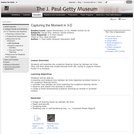
Students will examine the sculpture "Rearing Horse" by Adriaen de Vries. They will then draw and sculpt animals from life, trying to capture motion frozen in a moment.

Cardboard Automata are a playful way to explore simple machine elements while creating a mechanical sculpture. This activity was inspired by the Cabaret Mechanical Theatre, a group of automata builders based in England. Artists like Paul Spooner, Keith Newstead, and Carlos Zapata build beautiful narrative pieces using elegant mechanisms based on cams, gears, springs, and linkages. Working with simple materials, this activity is easy to get started, and may become as complex as your mechanical sculpture ideas.
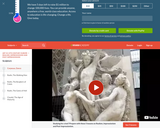
Jean-Baptiste Carpeaux, Dance, 1865-69, marble, 420 x 298 cm. (Musée d'Orsay, Paris). Commissioned by Charles Garnier for the facade of L'Opéra. In 1964 it was replaced by a copy executed by Paul Belmondo. Created by Beth Harris and Steven Zucker.

Watch a sculptor demonstrate the use of traditional tools—such as the tooth chisel, the point chisel, the drill, and the rasp—as he creates a finished figure from a block of marble. Created by Getty Museum.
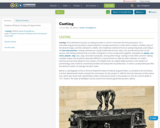
Sculpture Methods, Casting, Art Appreciation